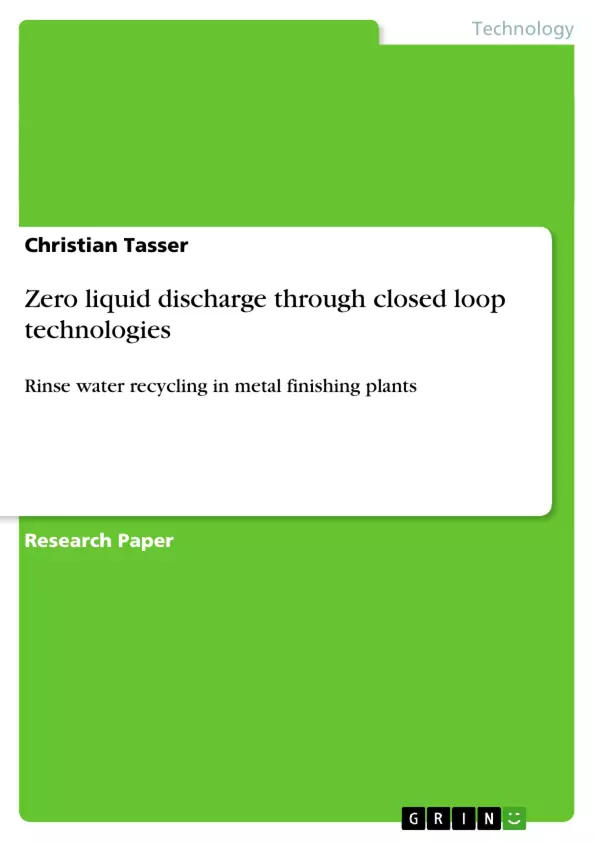The rinse water from five process lines at a plating shop is treated with the closed-loop water treatment systems consisting of Advanced Reverse Osmosis, Electrocoagulation and Electrodialysis. The product water is recycled back to the process lines.
Before the installation of the recycling system approximately 380,000 liter per day of wastewater were discharged from the process lines. With the operation of the closed-loop water treatment system the plant is saving 120,000 cubic meter per year of fresh water.
The company reduced costs for water usage, energy consumption, sludge disposal and chemicals in the wastewater treatment plant.
Inhaltsverzeichnis (Table of Contents)
- 1.0 Introduction
- 2.0 Process Description
- 2.1. Description of Applied Technologies
- 2.1.1. Critical and "Non-Critical" Rinses
- 2.1.2. Critical Rinses
- 2.1.3. "Non-Critical" Rinses
- 2.1.4. RO Systems (ROI and ROII)
- 2.1.5. Electrodialysis System (ED)
- 3.0 Cost, Water and Energy Savings
- 3.1. Estimated Water Savings
- 3.2. Estimated Energy Savings
- 3.3. Estimated Savings in Wastewater Treatment
- 4.0 Conclusion and Findings
Zielsetzung und Themenschwerpunkte (Objectives and Key Themes)
This paper details the design, installation and operation of a comprehensive closed-loop recycling system for a company engaged in Anodizing and Plating. The project is presented in three phases: Engineering, Implementation and Operational analysis.
- Design and Implementation of a closed-loop water recycling system
- Integration of various membrane and electrotechnologies for water treatment
- Analysis of critical and non-critical rinse water streams
- Assessment of water, energy, and wastewater treatment cost savings
- Evaluation of the environmental impact of the implemented recycling system
Zusammenfassung der Kapitel (Chapter Summaries)
- 1.0 Introduction: This chapter presents the overall context of the project, outlining its purpose and the three phases involved: engineering, implementation and operation.
- 2.0 Process Description: This chapter delves into the detailed description of the closed-loop water recycling system, highlighting the specific technologies employed, including Reverse Osmosis (ROI and ROII), Electrocoagulation (ED), and Electrodialysis (ED). It also categorizes the rinse water streams into "critical" and "non-critical" types, based on their chemical composition.
- 2.1. Description of Applied Technologies: This section provides a detailed overview of the different technologies used in the recycling system. It explains the distinction between "critical" and "non-critical" rinse water streams, their management strategies, and the specific treatment processes involved for each type.
- 2.1.1. Critical and "Non-Critical" Rinses: This sub-section introduces the concept of critical and non-critical rinses, defining their characteristics and importance in the recycling process.
- 2.1.2. Critical Rinses: This sub-section focuses on the treatment and management of critical rinses. It outlines the steps involved in treating these rinses, including electrocoagulation, reverse osmosis, and electrodialysis.
- 2.1.3. "Non-Critical" Rinses: This sub-section discusses the treatment process for non-critical rinses, highlighting the steps involved in their collection, filtration, and recirculation within the system.
- 2.1.4. RO Systems (ROI and ROII): This sub-section explains the role and functionality of Reverse Osmosis (RO) systems, specifically ROI and ROII, in the water treatment process. It outlines the operational principles and their importance in removing impurities from the rinse water.
- 2.1.5. Electrodialysis System (ED): This sub-section details the operation of the Electrodialysis (ED) system, highlighting its role in further purifying the rinse water by selectively removing dissolved ions.
- 3.0 Cost, Water and Energy Savings: This chapter explores the economic benefits of the closed-loop system, focusing on the estimated water, energy, and wastewater treatment cost savings realized.
- 3.1. Estimated Water Savings: This section provides a quantitative assessment of the water savings achieved through the implementation of the closed-loop recycling system.
- 3.2. Estimated Energy Savings: This section presents an analysis of the energy savings realized due to the closed-loop system, highlighting the impact on overall energy consumption.
- 3.3. Estimated Savings in Wastewater Treatment: This section explores the cost savings associated with reducing the volume of wastewater discharged and the need for external treatment.
Schlüsselwörter (Keywords)
The primary themes of this paper focus on environmental sustainability and process optimization in the metal finishing industry. This includes the application of closed-loop water recycling systems, utilizing a combination of advanced membrane and electrotechnologies such as Reverse Osmosis (RO), Electrocoagulation (EC), and Electrodialysis (ED). The study also emphasizes the cost-benefit analysis of these technologies, highlighting potential water, energy, and wastewater treatment cost savings.
- Quote paper
- Dipl.Ing. Christian Tasser (Author), 2003, Zero liquid discharge through closed loop technologies, Munich, GRIN Verlag, https://www.grin.com/document/75021



